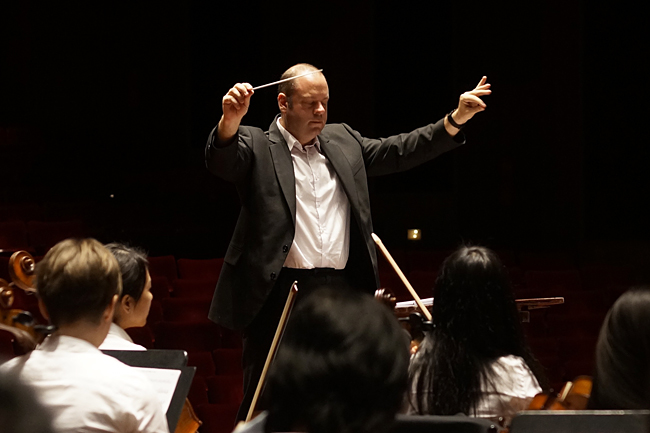Legends tell of the intrepid Viking explorer, Leif Erikson, who made landfall on North American shores some 500 years before Christopher Columbus ever set foot here. Now, like an adventurer discovering another new world, Leif Erikson Sundstrup is at the helm of an orchestra with Shen Yun Performing Arts.
Shen Yun is gaining international acclaim for a sound that is both classical and completely new to most Western audiences. Its orchestra combines the mystique of China’s rich 5,000-year-old culture with the grandeur of the Western orchestra. Alongside classical Western instruments like brass, woodwinds, and strings, it blends in traditional Chinese instruments such as the two-stringed erhu, the plucked pipa, and ancient percussion.
Although it is in the role of accompaniment to dance performance, the orchestra’s mesmerizing sound is as much a part of the Shen Yun experience as are the stories and legends on stage, the colorful ethnic and folk dances, the soaring vocal performances, the animated digital backdrops, or the brilliant costumes.
This month, Sundstrup and the Shen Yun Orchestra embark on Shen Yun's 2014 season. Under Sundstrup's baton, the orchestra will perform in theaters like the Kennedy Center in Washington, DC and New York's Lincoln Center.
The 2014 season is Sundstrup’s first season with the company. Like his namesake, the conductor relishes the opportunity to travel the globe, and has done so often. Now, he is eager to share Shen Yun's music with new audiences.
Is there any real connection between his upcoming tour and the voyages of the legendary explorer? “The name came from both the explorer, exactly 1,000 years my senior, and after my father, his name is Erik.”
A Diverse Background

The Leif Erikson of today was born in 1970 in Papua New Guinea, where his father worked. The family moved to Australia when he was two, and that is where he grew up. After completing his bachelor’s in music at the University of New England (New South Wales), Sundstrup then went on to earn his master’s degree in conducting from the London College of Music, where he received the Austin Fancourt Prize for outstanding musical achievement. He later earned a doctorate in music composition from the University of Wollongong in Australia. His personal accolades include winning the 1996 Symphony Australia National Conducting Competition and, more recently, the “Administrators’ Medal” for outstanding services to Australia’s Darwin Symphony Orchestra and the Northern Territory.
Sundstrup, who wears a permanent grin, is animated and
gregarious. It was he who, at the Shen Yun Symphony Orchestra’s performance at
Carnegie Hall in October, ended the concert by teasing the audience during the
final notes. It is his charisma, as well as talent, that had led him to conducting
what seems like a laundry list of all of Australia’s major orchestras—the Sydney
Symphony Orchestra (Assistant Conductor at the Sydney Opera House), the Melbourne
Symphony Orchestra (Associate Conductor), Queensland Symphony, State Orchestra
of Victoria, West Australian Symphony Orchestra, Tasmanian Symphony Orchestra,
the Darwin Symphony Orchestra (Chief Conductor and Artistic Director), and Australia
Ballet (Conducting Fellow). En route to Shen Yun’s New York headquarters, he was
also Resident Conductor of the Royal Oman Symphony Orchestra, performing
regularly for both the public and the Sultan’s private functions.
Now, he joins a diverse group of accomplished artists. The world’s premier
classical Chinese music and dance company, Shen Yun is based not in China
(where artistic freedom is still limited), but in New York. The company’s
dancers, among the world’s elite, are ethnic Chinese from around the world. The
musicians are an even more diverse bunch, as perhaps symbolized by the
company’s four conductors—in addition to Australia’s Sundstrup, Milen Nachev is
from Bulgaria, William Kuo from Taiwan, and Yohei Sato from Japan.

“I think it’s just a hotspot of great artistic talents, and it’s got every single thing going for it,” Sundstrup said.
At a rehearsal led by Sundstrup, who speaks (Australian) English, conversations can also be simultaneously heard in Mandarin, Russian, and Spanish. Yet, somehow, they make it work. “Shen Yun is like a family, and everyone gets along very well,” he said. “One thing that struck me, even just in rehearsals, is how everyone is so diligent with their attention and concentration.”
Sundstrup says he has seen a common reaction from audience members. “They all say similar things—that they feel this divine power coming out from the orchestra. And it’s not just based on the fantastic compositions that we get to perform, but also there’s an energy coming from the players.”
He sees the diversity of Shen Yun and the spiritual appeal of ancient Chinese culture as an asset in a market where many traditional orchestras are shrinking and have lost their inspiration.
“I think the orchestra is on the brink of getting not just an international reputation for innovation, but a reputation for artistic vitality,” Sundstrup said. “It’s growing very, very quickly and becoming something that no one will ever want to miss.”


